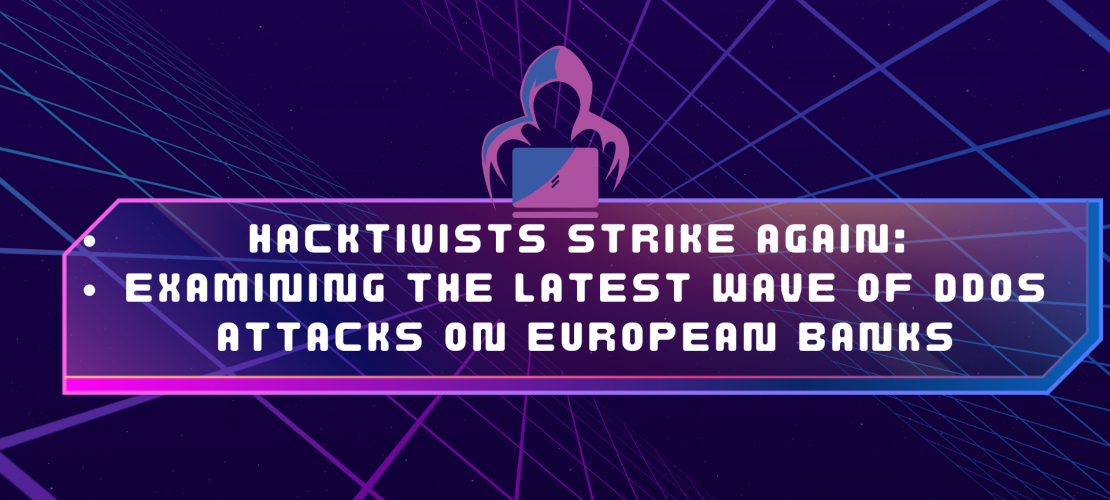In recent years, distributed denial-of-service (DDoS) attacks have become an increasingly popular tactic for hacktivists to voice their political or social grievances. These attacks are aimed at disrupting the services of targeted organizations by overwhelming their networks with a flood of traffic. In the latest wave of attacks on European banks, hacktivist groups have utilized DDoS attacks to make their voices heard and put pressure on financial institutions to change their policies.
The Rise of Hacktivism and DDoS Attacks
Hacktivism is a form of hacking that is motivated by political or social causes. Hacktivists are often associated with the Anonymous collective, a decentralized group of activists that have carried out a number of high-profile cyber attacks over the past decade. DDoS attacks are a popular tactic among hacktivists because they are relatively easy to execute and can be carried out anonymously using botnets.
The first wave of hacktivist DDoS attacks occurred in the early 2000s, with groups such as Electronic Disturbance Theater and the Electrohippies targeting government and corporate websites to protest various social and political issues. These attacks were relatively simple and unsophisticated, but they paved the way for the more advanced attacks that we see today.
Today’s hacktivist groups are more organized and have access to more sophisticated tools and techniques. The recent attacks on European banks, for example, were carried out using botnets made up of compromised IoT devices and servers. These botnets are capable of generating massive amounts of traffic, making it difficult for banks to defend against the attacks.
The Latest Wave of DDoS Attacks on European Banks
In early 2021, several European banks were hit by a wave of DDoS attacks that lasted for several weeks. The attacks were carried out by a group calling themselves the ‘Hacktivist Ghost Squad’ and were aimed at protesting the banks’ investments in fossil fuels and their role in funding the arms industry.
The attacks were carried out using a botnet made up of compromised servers and IoT devices. The botnet was capable of generating traffic at a rate of up to 500 Gbps, making it one of the most powerful botnets ever seen. The attacks targeted the banks’ websites and online banking services, making it difficult for customers to access their accounts.
The Impact of DDoS Attacks on Financial Institutions
DDoS attacks can have a significant impact on financial institutions, both in terms of financial losses and damage to their reputation. In the case of the recent attacks on European banks, the attacks caused significant disruption to the banks’ services, making it difficult for customers to access their accounts and carry out transactions.
Financial institutions are also at risk of losing customer trust and confidence following a DDoS attack. Customers may be hesitant to do business with a bank that has been the target of an attack, and this can lead to a loss of revenue and market share.
Protecting Financial Institutions from DDoS Attacks
Financial institutions can take a number of steps to protect themselves against DDoS attacks. Here are some of the most effective measures:
- Invest in DDoS mitigation services: DDoS mitigation services are designed to protect against DDoS attacks by filtering out malicious traffic and allowing legitimate traffic to pass through. These services are essential for financial institutions that are at high risk of attack.
- Implement network segmentation: Network segmentation involves dividing a network into smaller subnetworks, which can help contain the spread of an attack and limit its impact on the entire network.
- Increase Bandwidth Capacity: Increasing the bandwidth capacity of your network is another way to protect against DDoS attacks. By increasing the bandwidth, your network can handle a larger volume of traffic without being overwhelmed.
- Use Traffic Filtering: Traffic filtering is the process of filtering out traffic that is likely to be malicious. This can be done by using firewalls or other filtering tools to block traffic from known malicious sources or to block traffic that meets certain criteria, such as traffic that contains a high number of requests from a single IP address.
- Implement Access Controls: Access controls can also help protect against DDoS attacks. By implementing access controls, you can limit access to your network and prevent unauthorized users from accessing your systems. This can include implementing strong passwords, using two-factor authentication, and restricting access to certain parts of your network.
- Monitor Network Traffic: Finally, it is important to monitor network traffic to detect any unusual patterns or spikes in traffic that could indicate a DDoS attack. This can be done by using network monitoring tools or by working with a third-party provider that specializes in DDoS detection and prevention.
Conclusion
The recent DDoS attacks on European banks highlight the growing threat of hacktivism and the vulnerability of our increasingly digitized financial systems. As we navigate the complexities of the digital age, it is essential that we strive to strike a balance between security, privacy, and freedom of expression.
While the digital realm offers new avenues for protest and dissent, it also brings with it new challenges and risks. As we continue to grapple with these issues, one thing is clear: the need for robust cybersecurity measures and thoughtful policy-making has never been greater. The dialogue around hacktivism should not just revolve around its legality, but also its ethical implications and its role in the digital society of the future.




